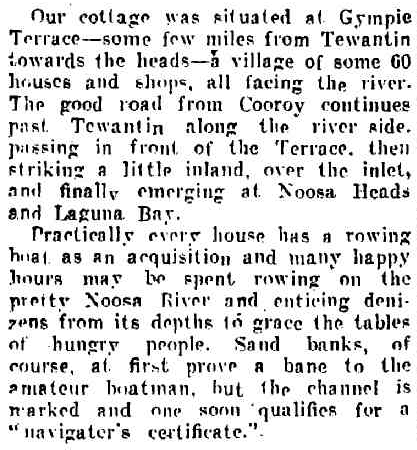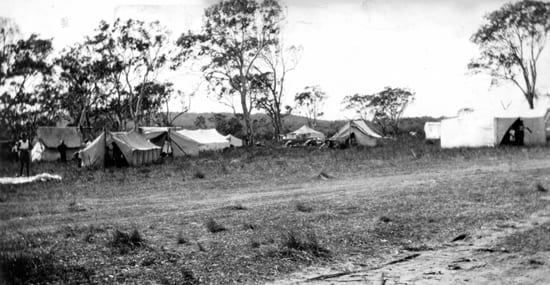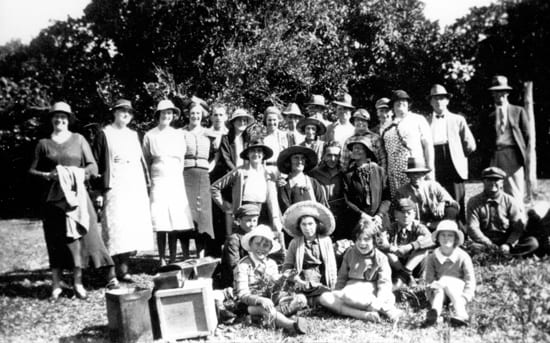Holidays are synonymous with Noosaville. Camping on the riverbank began almost as soon as Gympie Terrace was settled. There were frequent issues with the lack of toilets and fresh water from the 1920s into the 1960s, and occasional issues with flooding. But the location of Gympie Terrace is so beautiful, so wonderful, that people continued to come in droves and continue to do so today.
As early as 1878, the family of coachman George Paige would spend two months each year holidaying away from Gympie at their small cottage south of Weyba Creek.
The Gibson family made their house at Gympie Terrace their permanent home in 1888. But for several years prior to this it was their holiday home away from Gympie.

Daytrippers on the Noosa River, circa 1920s
The completion of the railway line from Brisbane to Gympie in 1891 brought many more visitors to the Noosa River, especially from the capital city. Camping was a regular activity along Gympie Terrace at Christmastime and Easter by the time of the First World War (1914-1918). In fact, by the early 1920s, sanitation was a pressing problem due to the increasing number of holidaymakers. The primitive facilities could not cope with the influx. The steady increase of car ownership through the 1920s and 1930s only exacerbated this problem.
The Massoud family, who had moved to Gympie Terrace in 1908, opened a grocery store that catered for holidaymakers as well as the handful of residents. Their boat, Riverlight, transported people from Tewantin to Gympie Terrace and Noosa Heads from 1915 and provided tours on the river and lakes also. In 1920, they opened the Favourite Café.

Jack, Howard & Daisy Parkyn aboard Miss Tewantin, late 1920s
Jack Parkyn returned to Gympie Terrace from Gympie in 1925 with his wife and young family, building the first house at Munna Point. Jack and Daisy bought the 60-passenger launch, Miss Tewantin, which took people to Gympie Terrace and Noosa Heads from Tewantin, and also provided tours to the coloured sands via Teewah. The Parkyns would soon build a shop at Munna Point and cleared the land on the far side of Russell Street, which became a popular camping ground. It quickly became so popular that the Council took over management of the site. Jack also built a number of holiday cottages, the rental of which included a small boat for each customer.

Parkyn’s holiday cottages and store on Russell Street, 1930s
Bridges connecting Gympie Terrace to Tewantin over Lake Doonella and to Noosa Heads over Weyba Creek were opened in 1929. Holidays at Gympie Terrace boomed. Every available space for a tent was taken at Easter and Christmas. Many rooms or whole buildings in the neighbourhood were rented out also.

Nambour Chronicle, 2nd October 1931

Sunday Mail, 10th January 1932

Furnished house for rent on Gympie Terrace. Image courtesy of State Library of Queensland

The Central Queensland Herald, 11th May 1933
Complaints were received by the Council in early 1931 regarding the lack of water and toilets at the camping sites on Gympie Terrace despite being charged 5 shillings (about $50) to camp. And the need for a “sanitary convenience” (toilet) near the ladies’ bathing shed at Gympie Terrace was raised in 1932.
Gympie Terrace and Munna Point were flooded on Christmas Day in 1933, ruining the holidays for many travellers.
Most tourists still arrived by train, alighting at Cooroy Station, but the construction of the Bruce Highway in the 1930s brought many more cars from the capital city, with record numbers of campers at Gympie Terrace, Munna Point and Tewantin for the Christmas holidays in 1934. Once again there were complaints about the lack of facilities: water, toilets and dressing sheds for both sexes. In response, Councillor Read noted that on one Sunday alone, 1027 motor vehicles went through Gympie Terrace. Furthermore, the poor condition of the bathing sheds was blamed largely on the holiday-makers themselves, as was the lack of water due to people letting the taps run. Nevertheless, it was agreed to address the requirements prior to Easter.

Camping grounds at Munna Point, 1930

Camping grounds at Munna Point, 1930

Gympie Terrace, 1935. Image courtesy of State Library of Queensland
The camping grounds and holiday houses for hire were once again filled to capacity at Easter, 1935.
In 1936, a regular, coordinated service of motor transport from Cooroy railway station to the settlements on the Noosa River was made available by Lionel Donovan and his fleet of cars.

Donovan’s Railway-taxi service outside the Parkyns’ Store on Russell Street, late 1930s
In anticipation of the holidays at the end of the year, the public jetties along Gympie Terrace were reconditioned by Council workers in September, 1937. The Tewantin Playground Committee erected three sets of swings along Gympie Terrace and Munna Point (as well as a slide near the Memorial Baths in Tewantin) in December. The camping sites and holiday cottages were full to capacity over the Christmas holidays once again.

The Telegraph, 1st January 1938
One of the first boat hire businesses on the river, Terrace Boat Hire, was begun by Tom and Audrey Salta in 1938, opposite their grocery shop, Terrace Stores, on the corner of Gympie Terrace and Weyba Road. It remains operational, under different ownership, as T Boat Hire today.
The wells and public water tanks were empty on 27th December 1938 and the Council was forced to cart water from Noosa Heads to supply the occupants of 125 tents along Gympie Terrace and a further 75 tents at Munna point. The dry conditions continued into January with many of the residents running out of water also.

Holiday makers at Gympie Terrace, 1930s
At Christmas, 1940, sanitation and water supply were issues for campers once again. Council agreed to install 5 bay lavatories at both Gympie Terrace and Munna Point and further facilities at the other camping sites. A water diviner was employed to find places to put down a bore for fresh water. In early 1941, a report recommended to make the public water supply fit for human consumption by cleaning out the existing well and finding a suitable timber for support that would not discolour the water. But it was not possible to replace the angle pieces and it was reported that the well would have to be re-sunk using the timber from the existing well.
Caravans became popular with holidaymakers from the 1940s onwards.

Russell Street and the Munna Point camping grounds, 1940s
After World War II, Leonard Ely bought back a number of boats that he had sold before his service in the army and set up the business, O Boat Hire, on Gympie Terrace, which he ran with his wife, Betty. The initial cost to hire a boat was 25 shillings a week (about $350 today). Len eventually sold up in 1974 but O Boat Hire continues to provide boats to holidaymakers today.
An aquatic sports day was held on the Noosa River at the height of the tourist season on New Year’s Day, 1949. In 1952 a power boat competition was held on New Year’s Day and this soon became an annual event. It developed into the Festival of the Waters by the early 1960s, kicking off with a street parade along the length of Gympie Terrace, to the delight of residents and holidaymakers alike.

Acquatic sports day on the Noosa River, New Year’s Day, 1949
Image courtesy of Sunshine Coast Libraries
Tourism increased dramatically in the 1960s and 1970s, especially due to the increased popularity of surfing. The roads were improved. The Noosa Six Mile Dam (now Lake Macdonald) was officially opened in 1965, providing reticulated water to the towns of Noosa Shire, including Noosaville. The number of hotels and motels grew. Flights direct from Sydney began arriving at Maroochydore Airport for the Christmas holidays in 1970, a huge boon for the tourist businesses of Noosaville.
Camping at Tewantin was banned in 1978. It had already ceased along Gympie Terrace. In 1990, it was banned at Noosa Heads, leaving Munna Point as the last camping space on the Noosa River. But hotels, motels, rooms, and houseboats for hire continue to abound along Gympie Terrace and in Noosaville, along with restaurants, bars, shops, parks and the river. It remains an incredibly popular place to holiday.
